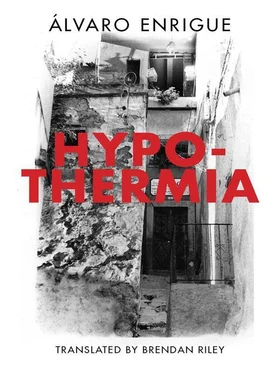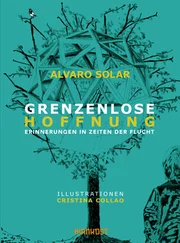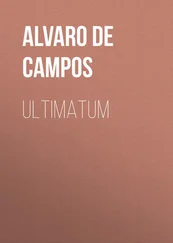At last it turned out that the Swiss did indeed look like gringo students, albeit without lips: my Colombian waiter, it seems, really does know it all. When I went downstairs at seven thirty the next morning, the hotel restaurant was already crowded with people — it had been years since I’d gotten up at such an insulting hour, perhaps not since the remote but haunting days when I’d been a history professor, watched television, and lived with Teresa in Mexico. The majority of the tables were occupied by regular tourists, but in the back of the room there was a group to which I obviously belonged: five tables, each one with two gringo students and a Latin American one, and then a sixth with only two students, which was obviously my table. I introduced myself there with the same sense of ennui that permits us artists to live so barbarously without ever paying the consequences. My producer was the young Swiss woman with the neutral French accent whom I’d spoken to on the telephone. She told me very cordially and efficiently that we had to hurry up if we wanted to film all the necessary footage, then she introduced herself and the cameraman who would be accompanying us. He was red-faced and blond, but he had a spectacular mass of hair between his head and his neck, and to be honest, more ennui than I did. I told them there was no problem, that I only drank coffee for breakfast — a lie — and as I looked around for a waiter, I took advantage of the moment to sneak a glance at the competition. None of the faces — each of which offered me a hostile glance — seemed familiar.
I had exactly fifteen minutes to get halfway acquainted with what we were going to do and to take three sips of my coffee. At seven forty-five people began heading up to their rooms to brush their teeth. At eight o’clock they combed and brushed our hair, got us into makeup in the hotel salon, where they also gave us some general instructions, and at eight thirty each group departed for its filming.
While they were getting us ready, I was unable to talk with any of the other chefs: they seated us well away from each other, whether to avoid friction or to keep us from communicating with each other I don’t know. I was constantly flanked by my producer and my cameraman. One chef — his height and hair suggested he might be Argentine — gave me a look that suggested that it was ridiculous to put up with such things. I spotted the other Mexican right away by his pointed loafers and impossible hair. He gave me a nasty look, partly as a result of the fact that he knew I was better than him and partly because if there’s one thing that people can’t stand, it’s when one of their compatriots gains a bit of recognition outside their country.
When the chief producer finished giving us the necessary instructions for the rest of the day, they started calling us individually, and we headed out, each tightly surrounded by our crew, straight to the parking area. There, six minivans awaited us, in which we departed the hotel one by one, like children heading out on a scavenger hunt. Descending into the hazy light of Lima and seeing by day how much it resembled Mexico City, I had the dizzy feeling of a Spanish speaker who hears Portuguese for the first time: you feel like you should understand it but something is out of place; it’s your language and it’s not your language — a parallel reality. I was coming back to a place that seemed like home but just wasn’t.
II
The truth is that once alone together inside the minivan, my Swiss companions turned out to be fine, warmhearted people. We went along the whole way chatting about everyday things, almost having fun. Every so often they revealed some detail about my life — my time spent in Christian Brothers schools, for example — or they quoted something I’d said in some old interview. They left me with the impression that they knew everything about me while I knew nothing about them: another dream, like the city of Lima itself, sprawling out with all its traffic and all its ugliness, behind which hid a sweetness that was only now becoming apparent to me.
Our first round of filming took place in a convent in the center of Lima. We spent hours shooting scenes in the cloister — one take after another, visits to the kitchen, exhaustive close-ups panning along the library shelves, moments of meditation in the refectory; all of it an atrocious pretense, tacky affectation.
The producer counted down from ten to three, then signaled the final numbers with her fingers, and I feigned the kind of distraction of which I’m fully capable — but not with a cameraman breathing down my neck and a gaggle of little Peruvian girls following us everywhere. I suppose that I’d never had so much attention in my whole life and I probably never would again. Even so, I couldn’t stop thinking about the days I’d spent digging up old recipes from the General National Archive in Mexico. I would have traded all those staring faces, which looked so much like success — the little girls’ curiosity, the cyclopean eye of the camera — for one second of the enormous attention Teresa once paid me as I expounded on the finer points of Mexican convent life in the seventeenth century, and cooked my colonial concoctions just for her.
We did additional shoots, similar to the one at the convent, at three other fairly important locations around Lima: the train station for the Cuzco line, a beach resort in Barranco, and the Parque del Amor, where the Swiss were horrified to see young couples in the shadows of the trees making out and groping each other with truly impressive inventiveness.
At the train station, the cameraman suggested some refreshment. I was faint from hunger, so it seemed like a magnificent idea. I could already taste my beer and whatever we were going to order for a snack when I saw that the Swiss woman had ordered water, nothing else. I looked at the cameraman with desperation and he looked back with the same. I ordered another coffee. We finished our “snack” in five minutes flat and then continued filming. I promised myself that once I got back to D.C. I’d give my Colombian waiter a raise.
On the way from the train station to the Parque del Amor I noticed how strange the façade was on the only really tall building — in no way did it qualify as a skyscraper — in the center of Lima. The cameraman pointed it out to me: it’s dark gray, made of concrete, without decorations or markings, like my life; a true visual nullity, an almost non-space with that very somber look one associates with the headquarters of some sort of secret police. I asked the driver what it was. He became quite serious and told me, in a very low, conspiratorial tone of voice, that it was the Suicide Building. What? I said to him. Those are the Ministry of Commerce offices, he explained to me, but they had to close them to the public because people would go up to the roof and jump off. Look up there at the top, he pointed with his finger, they put up a fence. It didn’t do any good, though — after they installed it people would take the elevator up to the ninth or tenth floor and jump out any window they found open.
I asked him with genuine interest if the suicide rate in Lima was very high. Extremely high, he told me with a sadness I did not expect. When they closed the Ministry of Commerce to the public, he continued, people started jumping off a new bridge across the Miraflores ravine. We were rounding a traffic circle, making the Suicide Building appear to turn away, revolving on an axis counter to our own, like a disgraced planet. My field of vision was moving past it, every moment further beyond the façade. I asked him if it could be the economic crisis, remembering that when I first started going out with Teresa everybody in Mexico was losing their job, so there was a net increase in the number of people who threw themselves in front of Metro trains. No, he told me, the ones who’ve got no money just steal, or they shoot themselves. The ones who jump do it because of love.
Читать дальше












